

Making a meal on an open fire doesn’t just taste delicious, it’s a great opportunity for the whole family to bond … but safety should always come first.

There’s something to be said about cooking a wholesome meal on an open fire, surrounded by nature and friends and family. The taste is a bit more complex than your stovetop dish — a smoky flavour added to charred meat or veggies (for example) give any dish that unique ‘outback’ taste.
However, as with all activities that involve an open fire, safety is of utmost importance, especially if you have little ones running around. In that vein, we’ve put together a list of safety tips and essential products that will make your ‘cooking around the campfire’ experience all the more enjoyable. So, make sure you gather all the right equipment before your next camping trip.
Fire Cooking: equipment
A successful fire cooking session always starts with the right equipment. Starting and controlling a campfire usually takes a bit of practice to get it perfect, but it’s always wise to start with good-quality dead wood (stored in a cool, dry place) and coal.
When lighting the fire, the best way to avoid burning yourself is to use extra-long matches. And it’s always a good idea to equip yourself with some heat-resistant gloves such as these funky-looking ones from OZ Braai . When cooking food over an open fire, always choose long-handed cooking utensils with wooden handles — this will extend your distance from the burning flames, hopefully preventing you from being as charred as your favourite cut of steak.
If you’re planning to cook a bunch of fiddly foods that may be tricky to handle over an open fire, you must get a grill grate/camp braai. This one in particular from OZ Braai can save you a world of pain, plus, again, creates a distance between you and the open flame, preventing you from the those pesky little burns. This Camp Braai measures 44cm x 33.5cm x 4.5cm and is inspired by South African tradition, tailored for Australian environments. With four heat levels and a basket with three adjustable settings for versatile cooking, the braai can be used for a wide variety of dishes, from roasts to breakfasts and everything in between.
If you’ve rocked up to camp and there is no designated firepit, it’s often easier to bring your own than to build/dig one from scratch. We recommend the Darche 450 BBQ Collapsible Fire Pit which has a foldable design to allow for easy setup, pack down and space-saving storage in the back of your vehicle or tucked away in your caravan’s tunnel boot. Constructed using food-grade stainless steel and from high-quality materials, a portable firepit can save you a lot of trouble/time when touring the great outdoors. But before striking the match, always remember to check if fires are permitted at the campground and ensure there are no Fire Bans in place.

Safety equipment
It’s important to be fire safe when campfire cooking, especially when it comes to putting out your fire. Aussie conditions (high temperatures and very flammable native flora) are essentially perfect for bushfires, so it’s important that your camp cooking activities don’t add to the problem.
If, for whatever reason, your fire gets out of control, it’s best to be prepared than be caught in a situation nobody wants to be in. We recommend the vehicle 'mini' fire extinguishers from Fire One . Designed to be stored in your tow vehicle, they contain a non-toxic, environmentally safe potassium-based agent which leaves no residue or mess to clean up. The Fire One extinguisher can also be used for a variety of fires including electrical and all types of household, fuel, gas and oil fires.
We must mention that all fire extinguishers come with a ‘use by’ date, which means they must be replaced after this time. An expired fire extinguisher could malfunction, rendering it useless when you actually need it in a dangerous situation, so it’s not something to overlook or ignore.
It goes without saying that if you’re heading to remote locations for your touring adventure, you should always have a first aid kit on board your vehicle. When you’re thousands of kilometres from civilisation and help, in the unforgiving outback, a vehicle first aid kit can be the difference between life and death. And it’s especially important if you’re planning some awesome nights around the campfire. We recommend the comprehensive Vehicle First Aid Kit from Aussie brand SURVIVAL for all your first aid needs. With its durable, rugged and water-resistant design, we believe it an absolute essential for any touring vehicle in Australia.
Some campfire safety tips
We’ve borrowed some vital tips from our sister company Hema Maps . Simply follow these rules to ensure your fire cooking experience is a safe one:
In campgrounds or caravan parks where fires are allowed, campers may light campfires in campground fireplaces if it is not a day of Total Fire Ban.
Don’t light fires on hot and windy days.
Some national parks do not permit fires at all so it’s always best to check with the local park’s office.
Use prepared fireplaces where they’re available, or as directed by signs.
Clear a 3m radius around the pit by removing any twigs, leaves and flammable debris, and ensure there are no low-hanging branches overhead.
Dig a pit around 30cm deep to contain the fire.
Use large rocks to create a border around the fire; avoid river rocks and layered rocks as they can explode when they get hot.
Keep a shovel and a bucket of water nearby (not sand or dirt as they stay hot for an extended period).
Extinguish the fire by pouring water on it.
Ensure that the fire is never left unattended and is completely extinguished (cool to touch) before you leave the campsite — hot coals can retain their heat for a very long time.
When it comes to firewood, your best bet is to bring your own — you can’t rely on there being sufficient supplies in the area around your camp.
Some public lands will have seasonal restrictions on the collection of wood, while national parks and reserves have a ban to preserve habitat.




